Northwest Park
In 1889 Oklahoma City was growing fast and soon dominated its rival cities and became the capitol of Oklahoma. The glory spilled over into dreams of becoming a grander, more splendid city. One of the ways it chose to achieve this was by the creation of a large-scale park system.
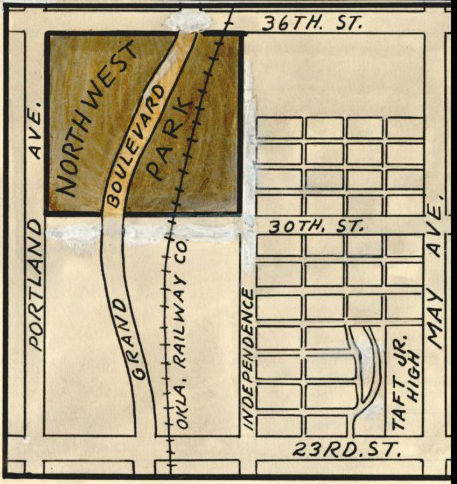 In 1909, W.H. Dunn, Superintendent of Parks in Kansas City and landscape architect, was hired to develop the initial Parks Plan. His plan called for a “Grand Boulevard” to encircle the city several miles away from the downtown area, with a major park planned for each of the four corners. The parks were called Northwest (Will Rogers), Southwest (Woodson), Southeast (Trosper) and Northeast (Lincoln). These parks were to differ from the City’s existing parks in that they were much larger and were expected to draw people from across the region. On June 11, 1910 the citizens of Oklahoma City approved a $400,000 bond issue for development of a park system and a “Grand Motor Raceway” around the city. In 1912, the City purchased a 160 acre dairy farm as part of the park system that eventually became Will Rogers Park.
In 1909, W.H. Dunn, Superintendent of Parks in Kansas City and landscape architect, was hired to develop the initial Parks Plan. His plan called for a “Grand Boulevard” to encircle the city several miles away from the downtown area, with a major park planned for each of the four corners. The parks were called Northwest (Will Rogers), Southwest (Woodson), Southeast (Trosper) and Northeast (Lincoln). These parks were to differ from the City’s existing parks in that they were much larger and were expected to draw people from across the region. On June 11, 1910 the citizens of Oklahoma City approved a $400,000 bond issue for development of a park system and a “Grand Motor Raceway” around the city. In 1912, the City purchased a 160 acre dairy farm as part of the park system that eventually became Will Rogers Park.
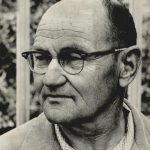 Henry Walter was hired in 1932 as the City Horticulturist and began designing the Park with a 30-acre horticultural garden. His college degree from Kansas State College (now Kansas State University), Manhattan was in Landscape Gardening. His first big assignment with the city was working with the National Park Service as a Cultural Foreman for projects at the Park. His gross salary was $167.02 per month. Henry Walter retired 39 years later in 1972 as the city’s horticulturist. He lived at Will Rogers Gardens with his family and was responsible for this park as well as overseeing the landscape and maintenance of all of Oklahoma City’s public space planting, including parks, medians and municipal flower beds.
Henry Walter was hired in 1932 as the City Horticulturist and began designing the Park with a 30-acre horticultural garden. His college degree from Kansas State College (now Kansas State University), Manhattan was in Landscape Gardening. His first big assignment with the city was working with the National Park Service as a Cultural Foreman for projects at the Park. His gross salary was $167.02 per month. Henry Walter retired 39 years later in 1972 as the city’s horticulturist. He lived at Will Rogers Gardens with his family and was responsible for this park as well as overseeing the landscape and maintenance of all of Oklahoma City’s public space planting, including parks, medians and municipal flower beds.
New Deal Programs
Northwest Park appeared on city maps since 1909, however development was delayed until the City Plan, developed by Hare & Hare, gave impetus to begin. The U.S. National Park Service, cooperating with the Oklahoma City Parks Department, developed the park design jointly. The U.S. National Park Service strongly advocated a set of design principles, primarily unspoiled natural beauty, maximizing scenic views, keeping service roads and buildings inconspicuous. They also advocated the use of native materials to harmonize park structures with each other and their surroundings.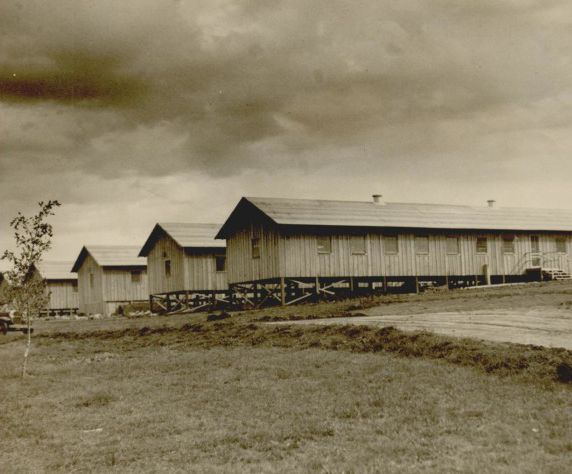 The Civilian Conservation Corps (CCC) was a work relief program that gave millions of young men employment on environmental projects during the Great Depression. Considered by many to be one of the most successful of Roosevelt’s New Deal programs, the CCC planted more than three billion trees and constructed trails and shelters in more than 800 parks nationwide during its nine years of existence. The CCC helped to shape the modern national and state park systems we enjoy today.
The Civilian Conservation Corps (CCC) was a work relief program that gave millions of young men employment on environmental projects during the Great Depression. Considered by many to be one of the most successful of Roosevelt’s New Deal programs, the CCC planted more than three billion trees and constructed trails and shelters in more than 800 parks nationwide during its nine years of existence. The CCC helped to shape the modern national and state park systems we enjoy today.
Executed by the work force supplied by the Civilian Conservation Corps (CCC) and the Works Progress Administration (WPA), they dammed two creeks and created a naturalistic landscape of small lakes, rolling hills, curving roadway, amphitheater, retaining walls, picnic shelters, rose and iris gardens, an arboretum, and many structures built from native red sandstone.
Company 868 of the CCC was assigned to Will Rogers Park. The first enrollees arrived October 12, 1933. Camp was set up in the southwest corner of the park, consisting of temporary wooden barracks with electricity, water and sewage. The CCC’s six month work period was extended to nine months, and park improvement work was continued to include the East Lake and dam, Rose Garden and native red sandstone structures found throughout the area.
Will Rogers
William Penn Adair Rogers was an American stage and motion picture actor, vaudeville performer, cowboy, humorist, newspaper columnist, and social commentator from Oklahoma. He was a Cherokee citizen born in the Cherokee Nation, Indian Territory.
Following the death of Oklahoma’s native son, Will Rogers, the Park Board changed the name of Northwest Park to Will Rogers Park in honor of this great American on June 24, 1936.
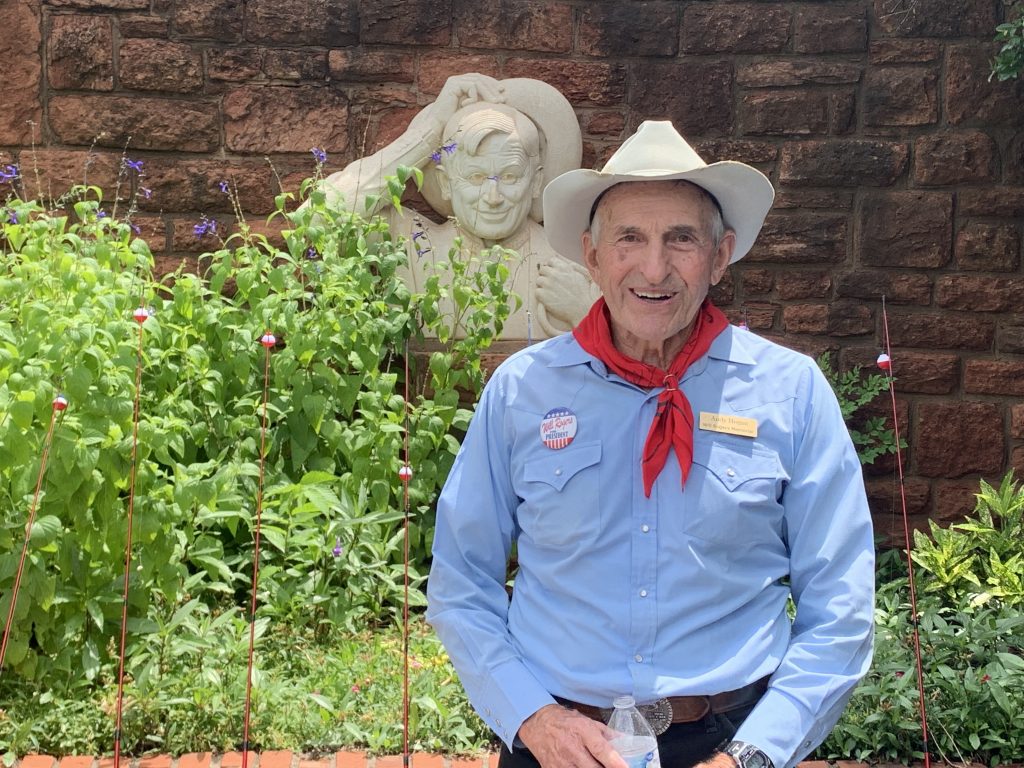
Tucked into a little corner in a small garden is a memorial to Will Rogers. Installed in 1954, it is carved out of the steep embankment on the eastern edge of the East lake. A concrete bust of the cowboy humorist and a bronze plaque decorate a stone wall set in a little patio that overlooks the lake. Will is scratching his head and looking toward one of the special gardens.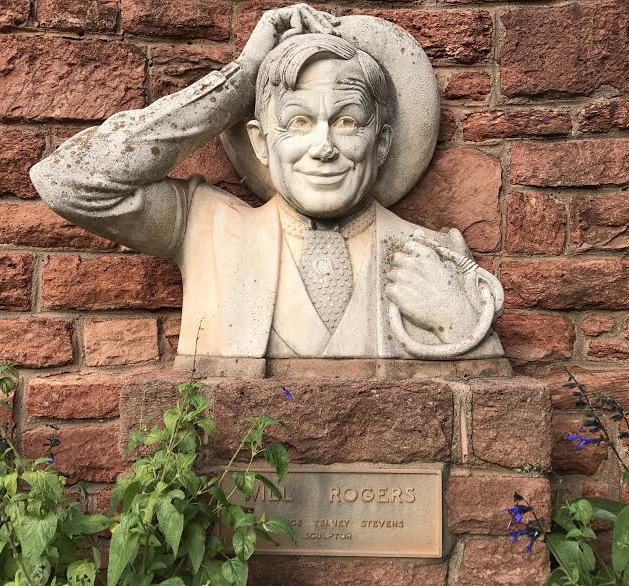
The bust of Will Rogers was created by Lawrence Tenny Stevens, and donated by the Auvergne Chapter of DeMolay. Lawrence Tenny Stevens was born in Massachusetts in 1896. His artistic talent in high school offered opportunities to study with Harvard students and he was later accepted to the Boston Museum School. Upon his return from WWI, he studied with Tiffany’s, American Academy in Rome, as well as studying in Egypt. Winning several prestigious international competitions for his sculpture, he met and became friends with Daniel Chester French, fellow American sculptor known for the statue of Abraham Lincoln in the Lincoln Memorial. This association led Stevens’ artistic focus to use his sculpture to glorify that which he believed was uniquely American West-themed body of work. He modeled and sculpted in clay, plaster, bronze and marble, everything from the animals and workers of the ranches to the champion bronco riders he saw at local rodeos. Stevens volunteered for military service once more during WWII. Upon his return, he settled in Tulsa for a short time before retiring to Arizona. He lived and sculpted in Tempe, Arizona until his death in 1972.
Exhibition Building
 The original Garden Exhibition building was built in 1938 as a WPA project for the Oklahoma City Council of Garden Flower Clubs. It housed a library, assembly room and kitchen, serving as a center for garden club activities. The Garden Exhibition Center came to fruition after many years of work in the park by the city garden clubs. It was owned by the City but was under the supervision of the Garden Flower Club council. Members of the garden clubs contributed $1.00 each to furnish and equip the center, along with beginning to accumulate materials for a library.
The original Garden Exhibition building was built in 1938 as a WPA project for the Oklahoma City Council of Garden Flower Clubs. It housed a library, assembly room and kitchen, serving as a center for garden club activities. The Garden Exhibition Center came to fruition after many years of work in the park by the city garden clubs. It was owned by the City but was under the supervision of the Garden Flower Club council. Members of the garden clubs contributed $1.00 each to furnish and equip the center, along with beginning to accumulate materials for a library.
By the 1960’s, the Garden Club Council saw the need for a new facility and persuaded the Oklahoma City Park Board to move forward with construction. In 1962, ground breaking for the new facility began. Inspired by the firm of Turnbull & Mills, this building was an example of Oklahoma mid-century modernism, characterized by clean, sleek lines and an open feel. The original design included an auditorium for presentations and classes, but those plans were never completed. The current display cases originally began as phone booths.
The facility is a central gathering point for many local horticulture organizations, with meeting rooms to accommodate over 100 people. The rooms may be rented for public meetings, education venues and exhibitions. Throughout the year, the staff provide free horticulture programs and garden tours upon advanced request.
Conservatory
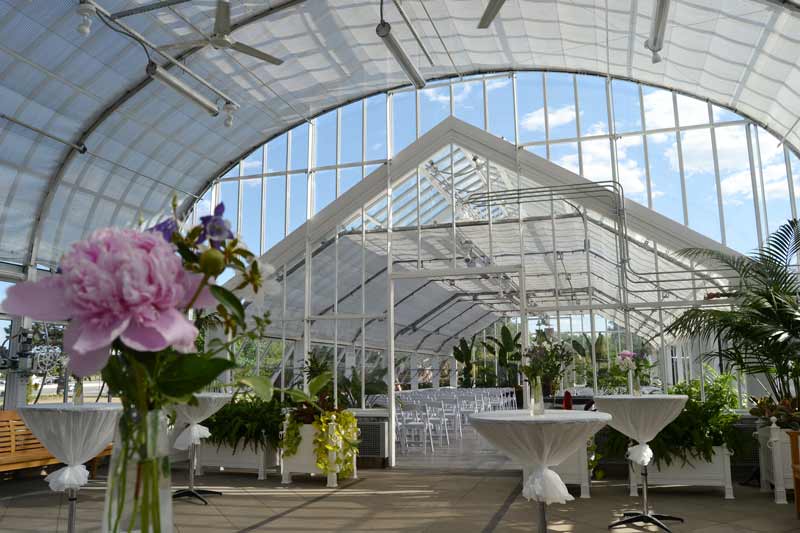 Built in 1924, designed by architects Lord and Burnham, the Conservatory was known as one of the best municipal greenhouses in the Southwest. The greenhouse was first installed inside Douglass Park near NE 10th and Eastern Avenue in 1924, on what were the grounds of the original State Fair park. This elegant late-Victorian steel framed wood and glass building is set atop a low red sandstone wall. In 1936 the Conservatory was moved to Will Rogers Park. It was erected onsite at the Gardens as a part of a “new” municipal greenhouse complex by the Works Progress Administration.
Built in 1924, designed by architects Lord and Burnham, the Conservatory was known as one of the best municipal greenhouses in the Southwest. The greenhouse was first installed inside Douglass Park near NE 10th and Eastern Avenue in 1924, on what were the grounds of the original State Fair park. This elegant late-Victorian steel framed wood and glass building is set atop a low red sandstone wall. In 1936 the Conservatory was moved to Will Rogers Park. It was erected onsite at the Gardens as a part of a “new” municipal greenhouse complex by the Works Progress Administration.
In 1970, the Conservatory was named in honor of Ed Lycan, the first employee of the Oklahoma City Parks Department. Providing an historical continuum from construction through moves for nearly two decades, Lycan’s close involvement was vital to the City’s horticultural efforts. A 2013 renovation project revitalized the historic structure, and the Conservatory now houses one of the state’s largest permanent collections of cactii and succulents. It is also available as an event hall for weddings and other celebrations.
With the Conservatory came four additional growing greenhouses; the fifth house was added in 1965. In these greenhouses, the Parks Department grew approximately 80,000 bedding plants annually. These were then planted throughout the City in the display beds of parks and center street medians. Some of these plants are also supplied to the Myriad Gardens, OKC Zoo, Fire Department, Police Department, Airports and other city buildings and locations.
Gardens
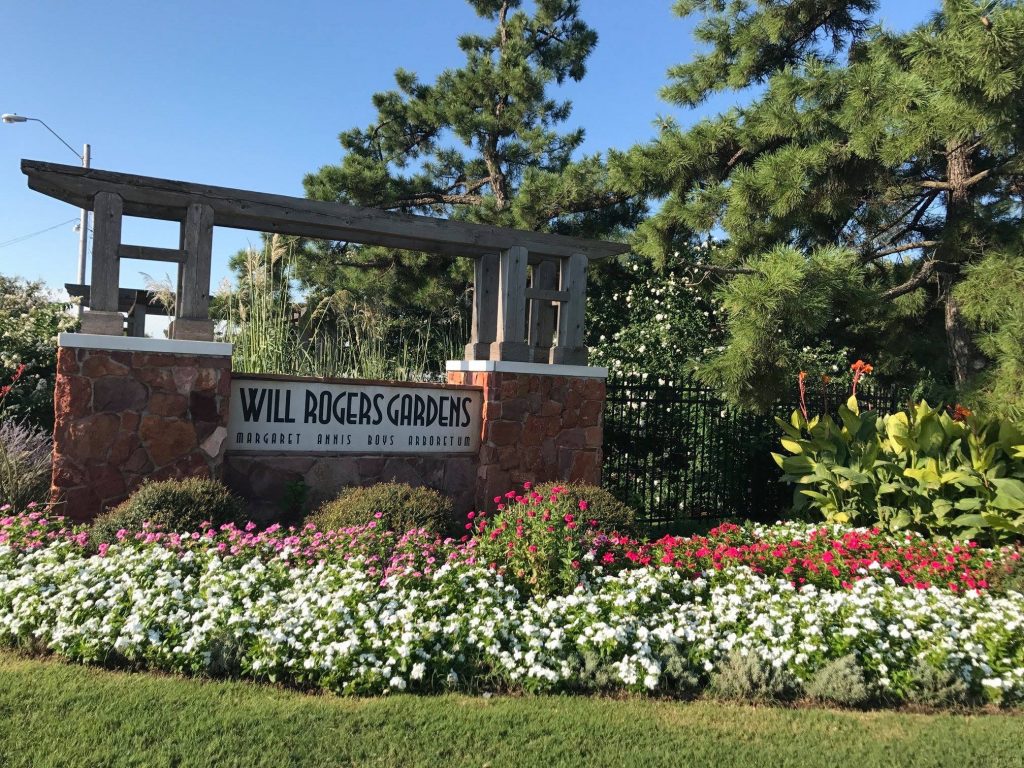 The park contains a 15 acre Arboretum, 15 acres of specialty gardens and the 1.63 acre Charles E. Sparks Memorial Color Garden. The arboretum is carefully laid out with groves of deciduous and evergreen trees, each grove being one genus, splashed across a large rolling meadow. Some are native; many are rare cultivars. Rolling terrain, various soil types, water and native prairie acres make a perfect natural setting for the Arboretum. It is located in the NW quadrant of the park. The rolling ten acres of the Margaret Annis Boys Arboretum features hundreds of varieties of trees, including Oklahoma native species as well as specimens rarely found in the state. The oldest trees in the arboretum were planted by horticulturalist Henry Walter in the 1930s. In September, 2009, the arboretum was renamed the Margaret Annis Boys Arboretum to honor the local philanthropist and gardening enthusiast who dedicated her many years to beautification projects on public lands in Oklahoma City. Thanks to a generous gift from the Oklahoma City Community Foundation, the arboretum now features an ADA accessible trail, plus new entry portals on the north and south side of the garden.
The park contains a 15 acre Arboretum, 15 acres of specialty gardens and the 1.63 acre Charles E. Sparks Memorial Color Garden. The arboretum is carefully laid out with groves of deciduous and evergreen trees, each grove being one genus, splashed across a large rolling meadow. Some are native; many are rare cultivars. Rolling terrain, various soil types, water and native prairie acres make a perfect natural setting for the Arboretum. It is located in the NW quadrant of the park. The rolling ten acres of the Margaret Annis Boys Arboretum features hundreds of varieties of trees, including Oklahoma native species as well as specimens rarely found in the state. The oldest trees in the arboretum were planted by horticulturalist Henry Walter in the 1930s. In September, 2009, the arboretum was renamed the Margaret Annis Boys Arboretum to honor the local philanthropist and gardening enthusiast who dedicated her many years to beautification projects on public lands in Oklahoma City. Thanks to a generous gift from the Oklahoma City Community Foundation, the arboretum now features an ADA accessible trail, plus new entry portals on the north and south side of the garden.
Will Rogers Gardens has been in use since the 1930’s as a horticultural showplace and production facility of approximately 32 acres, devoted to providing public beauty and horticultural education. A collaborative plan between the OKC Parks Department and National Park Service, and implemented by Civilian Conservation Corps (CCC) and Works Progress Administration (WPA), created a naturalistic landscape of small lakes, rolling hills, curving paths, and arboretum, specialty gardens for roses, iris, daylilies, peonies, herbs, cannas, and many structures built from native red sandstone. The horticultural components contain many beautiful display gardens created and maintained for the purpose of edifying and educating the visiting public.
The Will Rogers Garden is a legacy of beauty and grade of the garden designs, plantings, small lakes, an assemblage of idyllic scenic view so characteristically valued in the 1930’s built to enhance the garden’s formality and delightfulness. The lakes, rolling terrain and red sandstone park structures constructed during that era remain basically unaltered today, resulting in a setting familiar to the public for decades. It retains its integrity of location, setting, association and feeling and remains as an excellent representation of a community park.
National Registry
Will Rogers Gardens was listed on the National Registry of Historical Places in 2006. This prestigious honor was due in large part from the efforts of the Oklahoma Horticulture Society. Will Rogers Gardens remains a community garden with historic dedication to horticultural displays and areas of formal design.
Started by the National Garden clubs following WWI, the Blue Star Memorial markers are found across the country in every state, to pay tribute to the U.S. Armed Forces. The blue star was used on service flags to denote a service member fighting in the war. The program has since been expanded to include Memorial Markers and Memorial By-ways. These markers are used in National Cemeteries, parks, veteran’s facilities, and gardens.
The Rose Garden
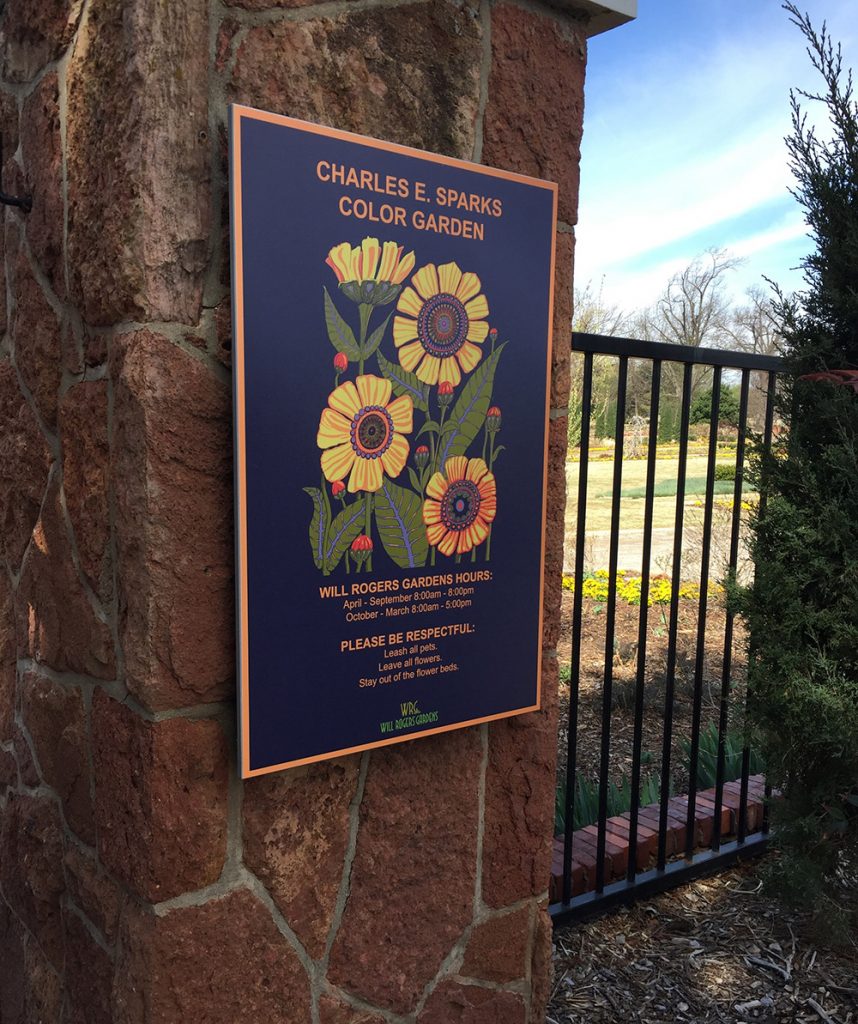 The centerpiece of the horticultural portion was the formal Rose Garden, now named the Color Garden, flanked by two small lakes, anchoring the even more formal horticultural gardens. The original planning and planting of the Oklahoma City Municipal Rose Garden in 1938 was sponsored by the Oklahoma Rose Society. The planting of 11,000 roses on 4 acres made it the fourth largest rose garden in the United States at that time. It was planned out, landscaped and was maintained by the Oklahoma City Parks Department. Funds were also provided through the cooperation and generosity of the OKC Chamber of Commerce and other civic groups, garden flower clubs, individual business institutions, local nurserymen and several nationally known rose nurseries. It was truly a garden “of the people” and “by the people.” It is named after former Parks Superintendent Charles E. Sparks.
The centerpiece of the horticultural portion was the formal Rose Garden, now named the Color Garden, flanked by two small lakes, anchoring the even more formal horticultural gardens. The original planning and planting of the Oklahoma City Municipal Rose Garden in 1938 was sponsored by the Oklahoma Rose Society. The planting of 11,000 roses on 4 acres made it the fourth largest rose garden in the United States at that time. It was planned out, landscaped and was maintained by the Oklahoma City Parks Department. Funds were also provided through the cooperation and generosity of the OKC Chamber of Commerce and other civic groups, garden flower clubs, individual business institutions, local nurserymen and several nationally known rose nurseries. It was truly a garden “of the people” and “by the people.” It is named after former Parks Superintendent Charles E. Sparks.
In 1950 the Rose Garden was modified by reshaping the beds inside the original outline, removing the concrete walks throughout the beds and surrounding them with concrete curbing. Over 4,700 new roses were planted on 8 acres in addition to the 195 roses from the original planting, at a cost of $5,000 in 1938. Through arrangements with leading hybridizers and propagators, the garden was supplied with the new introduction before those varieties were available to the public. Their purpose was to make the rose garden as complete as possible, and a “living catalog” for rose lovers. After this planting, the Will Rogers Rose Garden was said to offer “one of the most extensive showings of all types of roses in any rose garden in the United States and perhaps the world”.
A recent rose blight forced park horticulturalists to re-design the Garden beds with a variety of Oklahoma-proven perennials and annuals, giving homeowners the opportunity to see how different combinations of plant materials can have a dramatic effect in a home landscape.
Culberson Fountain
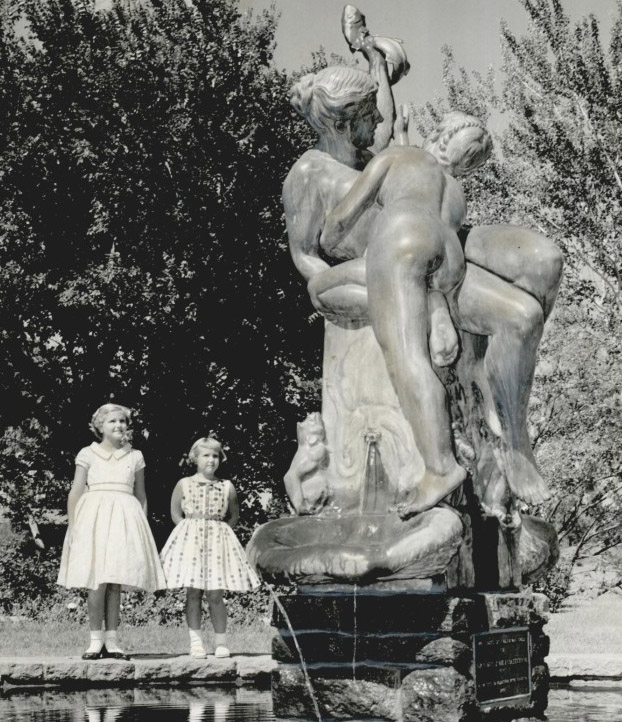 Richard Aigner, a German artist, designed the bronze statue located in the center of the Rose Garden. The statue, added in 1955, is of a mother and daughter. This 6-foot tall bronze fountain is said to depict a mother’s struggle to keep her daughter from crossing the threshold into adulthood. The sculpture was donated to the Parks Department in the 1930s by J.J. Culberson Jr., a local art collector who purchased the bronze from Munich artist Richard Aigner while on vacation in Paris, France.
Richard Aigner, a German artist, designed the bronze statue located in the center of the Rose Garden. The statue, added in 1955, is of a mother and daughter. This 6-foot tall bronze fountain is said to depict a mother’s struggle to keep her daughter from crossing the threshold into adulthood. The sculpture was donated to the Parks Department in the 1930s by J.J. Culberson Jr., a local art collector who purchased the bronze from Munich artist Richard Aigner while on vacation in Paris, France.
The story goes that J.J. Culbertson, on his first trip back to Europe after WWI, acquired the fountain sculpture. He ran across the sculptor in Paris. Richard Aigner of Munich had come to Paris to cast the sculpture, commissioned by a Bavarian nobleman for his estate. It was designed for a particular spot. A pool was to be the front piece for a planted background and the fountain the principal figure in it. At that time, Aigner was broke, his commission invalidated by the war’s outcome, and an expensive bronze figure his only asset. Culbertson visualized it adorning the garden of his Oklahoma City home on Ashton Place. The sculpture was packaged and crated through U.S. Customs, shipped from Paris to New York to Oklahoma City which was troublesome and expensive. Once the sculpture was at his home, one look told him it was too heroic in size for a small garden. So he donated it to the City of Oklahoma City. Not having a suitable spot for the sculpture, the Park Commission temporarily held it at Culbertson Park for 25 years until it was moved to Will Rogers Gardens.
Additional Gardens
The Living Legacy Garden, located north of the Garden Exhibition Building, was dedicated as a part of the city’s celebration of the Bicentennial anniversaries for our nation’s independence on July 4, 1776 along with the signing of the U.S. Constitution on September 17,1787.
The Xeriscape Garden, created in 1991, demonstrated water conservation landscaping, and horticultural techniques. It featured plants that thrive on local rainfall, or efficient irrigation systems and other xeriscape practices such as soil improvement, hardscape and mulches.
The Shepherd Garden was constructed in 1964 on a sloping embankment on the East Lake. A bronze plaque commemorates this garden dedicated to the Charter members of the Garden Flower Club. The garden, including the foot bridge crossing the East Lake creek, was a gift from the Shepherd foundation.
In 1967, Henry Walter, with the help of OKC Council of Garden Clubs, obtained a Sears grant to help purchase 500 plants and a sprinkling system. From other grants and donations from Warren’s Nursery, Mr. Walter planted additional azaleas to enlarge the trail to 2,500 azaleas.
The Rock Garden was designed and planted from 1952-1954. The tiers of red sandstone boulders were dragged into place by teams of horses and placed to form a naturalistic amphitheater. It showcased perennials and native wildflowers planted in the pockets formed between boulders. Because of the growth of trees in the area that have shaded out many areas, it has not been planted for many years.
Specialty Beds
Traditionally created in 1937 and made possible through the efforts of local garden groups, these beds contain many varieties of perennials, from new hybrids to old classics.
- Daylilies – June is the best time to view these beauties in bloom. The collection is cared for by the Central Oklahoma Hemerocallis Society.
- Iris – April is the best time to enjoy, and reblooming varieties appearing again in late October. This specialty bed is tended by Oklahoma Iris Society.
- Peony Garden – The oldest specialty bed; blooms appear around mid-April. The area is marked by a plaque in memory of Opal Brown Hamilton, a well-known local hybridizer, specializing in developing iris for late season blooms.
- Herb Garden – surrounds the gazebo, displaying herbs used for culinary, medicinal, cosmetic, and aromatic purposes. Maintained by the Oklahoma City Herb Club.